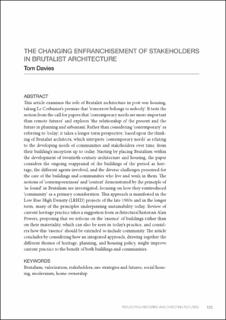| dc.description.abstract | The Brutalist movement formed the vehicle for post-war socialism to heal the country, focusing on welfare and quality of living for all, reflecting the utopian dream of its progenitors. It took its lead from earlier 20th century efforts to rehouse the poor from slums through blocks and garden cities, such as such as Park Hill, Sheffield and Alexandra Road, and Robin Hood Gardens in London amongst others. In Norway, it created residential buildings and pioneering public architecture, such as Regjeringskvartalet and the early Brutalist works of Ove Bang amongst others, with examples such as Samfunnshuset and Grensen. In recent decades, society has begun to reappraise Brutalism as part of our heritage, contrasting with an earlier negative interpretation and an increasing groundswell of public and professional bodies, who have joined residents and architects in championing and safeguarding its future. It divides purists and those who seek to update or free the tradition to allow for more modern interventions in updating buildings. The style also has detractors, who regard the period and its buildings as an aberration, which should never have occurred. The scale of the projects from residential complexes, to imposing public and private edifices, present major challenges in terms of conservation and management, but most importantly in terms of use. A key issue in this is the challenge designation and protection presents for planning the continued use of these buildings by which to guarantee their future. The diverse range of stakeholders, particularly in terms of residential buildings, often presents conflicting interests and viewpoints to be addressed in determining continued and new use, to secure the futures of such buildings. This abstract follows a 2014 Masters dissertation, which looked at developing an approach stakeholder interest mapping and engagement and determining sustainable futures for Brutalist buildings, both private and public and seeks to gain critical insights into the interests and aspirations of those involved. The 2012 study built upon professional work, engaging with Brutalist heritage through planning in the UK and Norway and has since been further developed. The paper resulting from this abstract, will demonstrate the approach to securing sustainable futures for these buildings in full and present within the context of the increasing importance post-war architecture is given in heritage protection terms. | |
